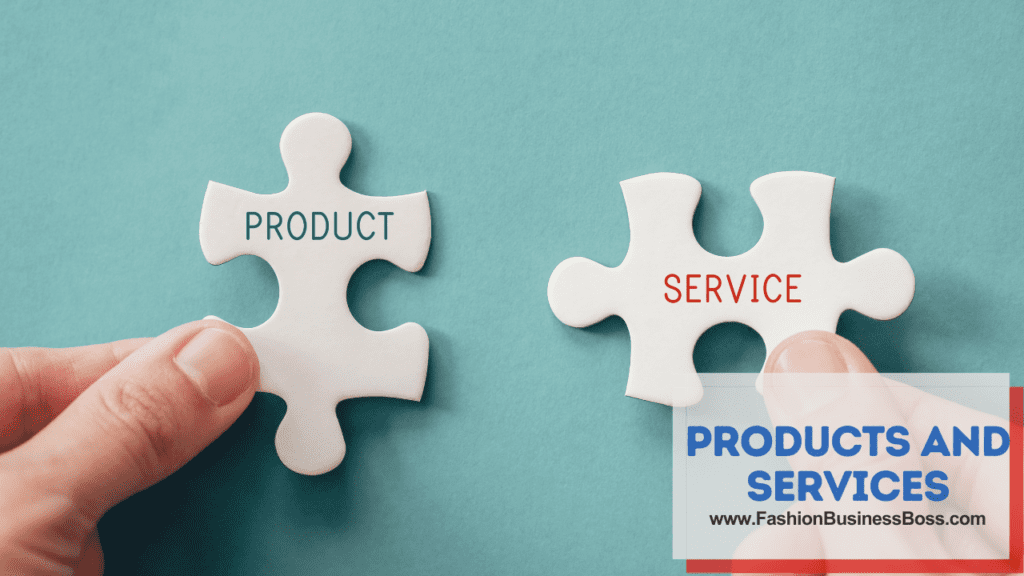Starting a clothing company is an exciting venture, but growth in this competitive industry requires careful planning and strategy. A well-thought-out business plan is your roadmap to navigate the complex terrain of the fashion world and achieve your entrepreneurial dreams.
To create a winning clothing company, start with a compelling executive summary. Delve into your unique brand, market research, products, marketing, and financial plans. Highlight sustainability, team, funding needs, and growth strategies for achievement.
In this article, we’ll guide you through the process of creating a strong clothing company business plan.
Executive Summary

The executive summary serves as the opening section of your clothing company’s business plan. It plays a pivotal role by offering a brief yet clear presentation of essential aspects. This includes your company’s mission, which outlines its primary purpose, your vision for its future, and the objectives you aim to achieve.
Within this section, it’s crucial to include a brief description of your brand. This description should encapsulate the essence of your clothing line, emphasizing its uniqueness and what sets it apart in the market.
Identifying your target market is equally important. Briefly discuss who your ideal customers are, their characteristics, preferences, and purchasing behaviors.
Furthermore, the executive summary presents a summarization of your financial projections. It provides an outline of your expected income, expenditures, and financial outlook. This concise section acts as an attention-grabbing introduction, capturing the interest of potential investors, partners, or lenders who are reviewing your business plan. It’s essentially the ‘hook’ that draws them in to explore the full scope of your clothing company’s potential.
Read more about: Building Your Brand: A Clothing Brand Marketing Plan
Company Description
The company description section of your business plan offers an opportunity to provide a more detailed view of your clothing company’s background and key attributes.
Start by elucidating your brand’s Unique Selling Proposition (USP). This is what distinguishes your designs from those of your competitors. Highlight what makes your clothing line special – whether it’s exceptional quality, innovative designs, affordability, or a combination of these factors.
This section should also delve into the practical aspects of your business. Discuss your company’s legal structure, which could be a sole proprietorship, partnership, LLC, or corporation. Clarify your business’s location, whether it operates from a physical store, online, or both.
Furthermore, touch upon any strategic partnerships you’ve established. Partnerships can include collaborations with suppliers, distributors, or other businesses that complement your clothing brand. Explain how these partnerships contribute to the growth and stability of your company.
By offering these insights, the Company Description section paints a comprehensive picture of your clothing company, outlining its unique strengths, legal framework, operating context, and strategic relationships. This helps potential stakeholders, such as investors or partners, better understand your business’s foundation and potential.
Market Research
Market research is a fundamental step in building a solid foundation for your clothing company. It’s all about gaining a deep understanding of your potential customers, the market, and your competitors.
Start by thoroughly studying your target market. This involves digging into the demographics, which means gathering information about the age, gender, income level, and geographic location of the people who are most likely to buy your clothing. Understand their preferences and buying behaviors – what styles they prefer, how they shop, and what influences their purchasing decisions.
Next, it’s essential to analyze your competitors. Look at other clothing companies in your niche and assess what they offer. Identify what sets your clothing apart – that’s your competitive advantage. It could be unique designs, pricing strategies, superior quality, or exceptional customer service.
Incorporate data into your plan regarding the size of your target market and the trends in the fashion industry. This information helps stakeholders understand the potential and growth opportunities for your clothing company.
By conducting comprehensive Market Research, you provide a clear and data-backed foundation for your business plan. This allows investors, partners, or lenders to see that you’ve done your homework and have a well-informed strategy for entering the market.
Products and Services

In the products and services section of your business plan, it’s essential to provide a comprehensive description of your clothing line. This is where you paint a clear picture of what you offer to your customers.
Start by delving into the details of your clothing designs. Describe the styles, colors, and themes that define your brand. Include information about the materials you use, emphasizing their quality and durability. Explain the manufacturing processes involved, whether your products are handcrafted, sourced from specific regions, or produced using innovative techniques.
If you have plans for expanding your product offerings in the future, mention these in a straightforward manner. This could include introducing new clothing lines, accessories, or complementary items.
Moreover, highlight any unique features or innovations in your products. Is there something special about your designs or materials that set your clothing apart from others in the market? Whether it’s eco-friendly materials, custom tailoring options, or a commitment to ethical production, make sure to detail these distinguishing factors.
By providing a thorough description of your clothing line and its unique attributes, this section enables potential stakeholders to grasp the essence of your brand and the value it brings to customers. It’s about presenting your products in a clear and engaging manner, making them stand out in the competitive fashion industry.
Read more about: Cashless Couture: Opening Your Clothing Store with No Budget
Marketing and Sales Strategy
In the marketing and sales strategy section of your business plan, you need to outline your approach to connect with your customers and make your clothing line visible in the market.
Start by detailing your marketing plans. Explain how you intend to reach your target audience. This includes the use of advertising, social media, and other promotional channels. Be specific about which platforms or methods you’ll utilize, like online ads, social media posts, or email marketing campaigns.
Discuss your pricing strategy. Clearly state how you’ll set the prices for your clothing items. Will you aim for affordability, premium pricing, or something in between? Explain your reasoning behind the chosen pricing strategy.
Elaborate on your sales tactics. How do you plan to persuade customers to make a purchase? This could involve offering special discounts, creating loyalty programs, or providing exceptional customer service.
Lastly, include your distribution plan. Specify whether you’ll sell your products online through your website, through retailers, or both. Outline your approach to getting your clothing into the hands of your customers.
By laying out your marketing and sales strategy in this manner, you provide a clear roadmap for how you’ll introduce your clothing line to the market, attract customers, and ultimately, generate sales. This section helps stakeholders understand your practical approach to selling your products.
Financial Projections
The financial projections section holds significant importance, especially for potential investors and lenders evaluating your clothing company’s viability.
Within this section, it’s imperative to present a detailed financial forecast. This includes creating income statements, balance sheets, and cash flow projections. These documents offer a clear picture of your company’s financial health and direction.
To ensure transparency, explain the assumptions and methodologies used to derive these financial projections. Detail how you arrived at your revenue estimates, anticipated expenses, and cash flow calculations. Providing a breakdown of your financial modeling process helps stakeholders understand the basis for your projections.
Moreover, highlight your break-even point, which signifies the point at which your revenues cover your expenses, resulting in neither profit nor loss. This is a crucial metric, as it indicates when your clothing company is expected to become financially self-sufficient.
Lastly, outline the timeline for achieving stability. Explain when you anticipate your business will start generating a profit based on your financial projections. This timeline provides insight into the long-term financial prospects of your clothing company.
Operations and Management

In the operations and management section of your business plan, you’ll provide a comprehensive overview of how your clothing company functions on a day-to-day basis.
Begin by outlining your operational processes. Explain how you handle production, from design to manufacturing, sourcing of materials, and maintaining quality control. Detail the steps involved in bringing your clothing line to life, ensuring a clear understanding of your operations.
Next, introduce your management team. Share information about the individuals who lead your company and their relevant experience in the fashion industry. Describe their roles and responsibilities within the organization, highlighting their expertise in areas crucial to your business’s growth.
Discuss your relationships with suppliers and any strategic partnerships you’ve established. Explain how these partnerships contribute to your company’s operations and growth. Whether it’s securing materials, distribution support, or other key elements, clarify how these connections bolster your clothing company.
Read more about: Building Your Brand: A Clothing Brand Marketing Plan
Funding Requirements
The funding requirements section of your business plan is crucial if you’re seeking external financial support for your clothing company. Here, you must provide a clear and honest account of your financial needs.
Start by specifying the amount of funding required. Be precise about the monetary figure you’re seeking to secure. Whether it’s for building up inventory, launching marketing campaigns, or expanding your product line, articulate how you intend to allocate the funds.
Transparency is key. Explain in straightforward terms the reasons behind your financial needs. If it’s for inventory, describe how this will bolster your ability to meet customer demand. If it’s for marketing campaigns, detail the strategies and expected outcomes. In the case of expanding your product line, clarify how this expansion aligns with your company’s growth strategy.
By presenting a transparent and well-defined picture of your funding requirements, you provide potential investors, lenders, or partners with a clear understanding of where their financial support will be directed and how it will contribute to the advancement of your clothing company. This section is vital for building trust and demonstrating fiscal responsibility.
Sustainability and Ethical Practices
In the sustainability and ethical practices section of your business plan, you have the opportunity to showcase your clothing company’s dedication to responsible business practices.
Given the increasing importance of sustainability and ethics in the market, it’s vital to emphasize your commitment to these values. Begin by explaining how you source materials for your clothing line. If you prioritize eco-friendly or ethically sourced materials, make that clear. Describe any steps you take to minimize waste or reduce your environmental footprint during the production process.
Ensure that you highlight your commitment to fair labor practices. Share how you treat and compensate your employees ethically and equitably. Detail any measures you’ve implemented to ensure safe and fair working conditions.
Mention any certifications or partnerships that reflect your dedication to sustainability and ethics. These may include certifications for eco-friendly materials or collaborations with organizations that share your values.
By clearly articulating your commitment to sustainability and ethical practices, you demonstrate to stakeholders that your clothing company operates with integrity and cares about its impact on people and the planet. This section underscores your responsibility as a business and your alignment with conscientious consumer values.
Growth Strategy

In the growth strategy section of your business plan, you’ll lay out your roadmap for expanding your clothing company in a straightforward manner.
Start by outlining your plans for scaling the business. Describe how you intend to grow, whether through increasing sales, expanding your customer base, or entering new markets.
Discuss the possibility of expanding into new markets. Explain which regions or demographics you’re considering for future growth. Highlight any market research that supports these expansion decisions.
If you plan to introduce additional product lines, detail these new offerings. Explain how they complement your existing clothing line and cater to evolving customer needs or trends.
Collaborations with other brands can be a valuable strategy. Discuss potential partnerships and how they align with your overall growth plans.
Lastly, provide a clear picture of how your business will evolve over time to meet changing customer demands. Adaptation and evolution are key in the ever-changing fashion industry, so elucidate your strategies for staying relevant and responsive to customer needs.
Read more about: Building a Legacy: Strategies for Clothing Brand Achievement
Conclusion
Creating a clothing company business plan is a labor of love that requires thorough research and strategic thinking. Remember that a well-crafted plan not only guides your company’s growth but also serves as a powerful tool to attract investors and partners who share your passion for fashion. With dedication and a solid plan in place, your clothing company can stand out in the competitive world of fashion and make a lasting impression.
Frequently Asked Questions

Q: How important is the executive summary in a clothing company’s business plan?
A: The executive summary is crucial as it provides an overview of the company’s mission, vision, and objectives, serving as a teaser for potential investors and partners.
Q: Why is market research essential in a business plan?
A: Market research helps understand the target market’s demographics, preferences, and buying behaviors, enabling better decision-making and competitive advantage.
Q: What should be included in the products and services section of a business plan?
A: The products and services section should detail the clothing line, materials, manufacturing processes, potential expansions, and unique product features.
Q: How do I create accurate financial projections for my clothing company?
A: Creating accurate financial projections involves detailing income statements, balance sheets, cash flow forecasts, explaining assumptions, and highlighting break-even points.
Q: What should be emphasized in the sustainability and ethical practices section?
A: In this section, emphasize how materials are sourced, fair labor practices, environmental impact reduction, and any certifications or partnerships that reflect your commitment to sustainability and ethics.
To learn more about starting your own clothing business, check out my startup documents here.
Please note that the contents of this blog are for informational and entertainment purposes only and should not be construed as legal advice. Any action taken based on the information provided in this blog is solely at your own risk. Additionally, all images used in this blog are generated under the CC0 license of Creative Commons, which means they are free to use for any purpose without attribution.

Meet Shawn Chun: Entrepreneur and Fashion Business Fan.
I’m a happy individual who happens to be an entrepreneur. I have owned several types of businesses in my life from a coffee shop to an import and export business to an online review business plus a few more and now I create online resources for those interested in starting new ventures. It’s demanding work but I love it. I do it for those passionate about their business and their goals. That’s why when I meet a designer or boutique owner at a craft fair, farmers market, retail location or anywhere else I see myself. I know how hard the struggle is to retain clients, find good employees and keep the business growing all while trying to stay competitive.
That’s why I created Fashion Business Boss: I want to help fashion business owners like you build a thriving business that brings you endless joy and supports your ideal lifestyle.

